Through the years, expressionism has often tapped into the tragic vein. The artist Jay Milder, meanwhile, has always gone the other way. His buoyant paintings and works on paper, now brightening the airy Quogue Gallery in "Jay Milder—Noah’s Ark: Many Visions,” is the optimistic antidote to any expressions of anguish, and a reminder that power in painting comes in many forms.
The keynote is Milder’s relentlessly positive painting, Smiling Universe, a densely worked yet light-filled ode to joy, its impasto whipped to crests and peaks that spill over the canvas edge. The cosmos pulses with bright greens and pinks, thickly painted up and down, swirling with energies that only the most liberal palette can convey. In the artist’s words, “It has to do with the primal sparks that floated free when the big bang happened and are still out there, traces of what I call the Eternal Becoming.”
.
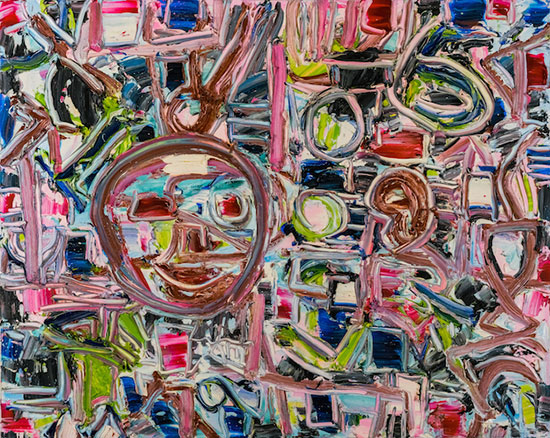
"Smiling Universe" by Jay Milder, 1979. Oil on Canvas, 30 x 24 inches.
.
The other paintings on view at the Quogue Gallery are correspondingly rich in texture and incident. Having scouted out the show online at Hamptons Art Hub, where it was previewed prior to the opening reception, I had a certain preconception from the onscreen image that the colors in Noah’s Ark 188 would match the confectionary vibrancy of Smiling Universe. Yet when I saw it at the gallery, the swirling pink and yellow is balanced by an oceanic passage of greens and blues at the center that contains the impression at a lower decibel level, making it more introspective.
.

"Noah's Ark 188" by Jay Milder, 1987. Acrylic & oil on canvas, 22 x 28 inches.
.
It is Noah’s Ark 188 that opens the Kabbalistic dialogue that is the subtext of the show, with its running allusions to numerology and Biblical iconography. The image of the ark, for instance, floats along in several of the works (look for the hull and two vertical towers, like smokestacks), along with Jacob’s ladder, the serpent and a blackboard full of numbers dominated by 3 and 8.
Before disappearing down the rabbit hole of Kabbalah, let me point out that these references are teamed with a range of other metaphysical ideas, including the Taoist concept of wu wei (loosely translated “letting go”) and a range of other symbols (including birds) from many cultures.
Milder inscribes the numeral 3 with a loaded brush into the generous curves of the painting Bird Ark (2007), the way that Jack Tworkow and Lee Krasner toyed with hieroglyphs and signs. The codes are the dramatic basis for Numerology 7, with symbols tumbling from every direction in an ecstatic profusion of meaning that complements the physical joy of painting. The day I visited the sunlit gallery, the French doors had been flung open at one end to the street and garden outside; the hum of holiday activity was the ostinato below the buzz of vibratory color on the walls.
.
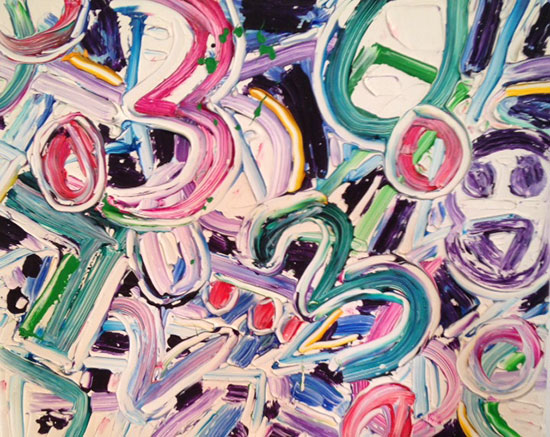
"Bird Ark" by Jay Milder, 2007. Acrylic, Oil on Canvas, 22 x 28 inches.
.
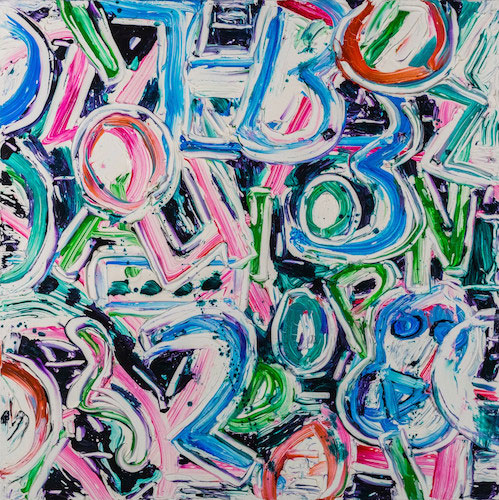
"Numerology 7" by jay Milder, 2001. Oil on canvas, 30 x 30 inches.
.
The polyglot range of symbolism is directly expressed by the many works on paper that make the show so intimate. The viewer can almost hear the ripple of oil stick across textured rag paper in #18, its white, red and aqua figures and numbers floating weightlessly over a black background.
.

"#18" by Jay Milder, 2014. Oil Sick on Rag Paper, 12 x 18 inches.
.
One inspired curatorial idea was the presentation of #25 “horizontally,” lying on its back in a vitrine at the center of the room just below waist level, requiring the viewer to bend and explore it from the point of view at which it was made. Milder, like many Abstract Expressionists, is not an easel painter. Examining the work from the maker’s angle, pondering the play of numbers and geometry from an elevated view, makes all the difference.
.
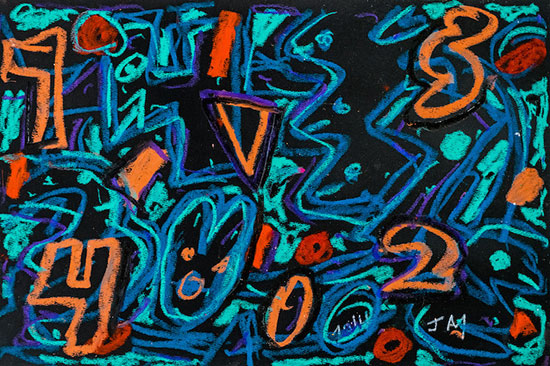
"#25" by Jay Milder, 2011. Oil stick on rag paper, 12 x 18 inches.
.
Jay Milder’s story is a throwback to the heroic age of New York painting. He was born in Omaha in 1934, revealed his talent as a draftsman in high school and dropped out of school at age 17 to head to Manhattan. He made his living by plying a pushcart on the Lower East Side. Making his way to Paris in 1954, he studied at the Académie de la Grande Chaumière under the famous Andre L’Hote and served an apprenticeship with the sculptor Ossip Zadkine.
During that first trip to Europe, he was wowed by two expressionist masters of texture and the figure, El Greco and Chaim Soutine, whose technical experiments are part of his vocabulary, especially in the paintings. The admirable range of Milder’s cultural references grew when he left France for the Spanish neighborhood of Morocco.
When he returned to the United States in 1956, he studied at the Art Institute of Chicago and made his debut with the Momentum Group, whose members were known for their international taste in symbolism. One of the most rewarding aspects of the show at Quogue is the conversation in many tongues that it opens, especially via the works on paper. These pieces are like the travelogue of a fortunate painter who was always in the right place at the right time.
Milder was always lucky in his teachers. His next great master after he left Chicago was Hans Hofmann. Milder joined the celebrated New York-based Hans Hoffman School of the Arts in Provincetown, and the rich impasto and scraped rectangles of blues intermingled with whites bear the influence of the Bavarian master.
Milder followed Hofmann to an appreciation of positive space in painting. That positive attitude is also reflected in the emotions and philosophy of the work, which embodies the kind of hope that makes his art “comic” in the same sense that Dante’s masterpiece is called “The Divine Comedy.”
The primary symbol of the comic promise of the work gives the show its title, “Noah’s Ark: Many Views.” As the artist notes in a statement, “I use Noah’s Ark because he received the rainbow as covenant.” The panoply of vivid tones in paintings such as Smiling Universe brings the rainbow to the canvas. Even the colors of the oil stick on black paper, such as #14, have an electric quality, the bounce of pure pigment on the retina.
.
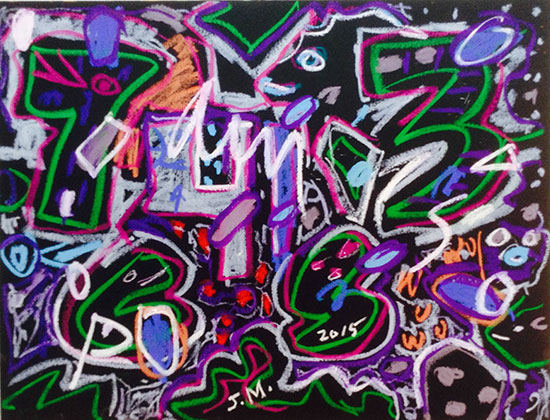
"# 14" by Jay Milder, 2015. Oil Stick on Rag Paper, 20 x 26 inches.
.
By contrast, a meditative group of black and white works on paper (the white line a ghostly, pale presence as it caroms from edge to edge) reveals the Kabbalist iconography and numerology as illuminated manuscripts to be read (AS 18, for example, with its doubling of figures is a puzzle). The codes engage on an intellectual level even as the gestures and textures hold the eye.
.
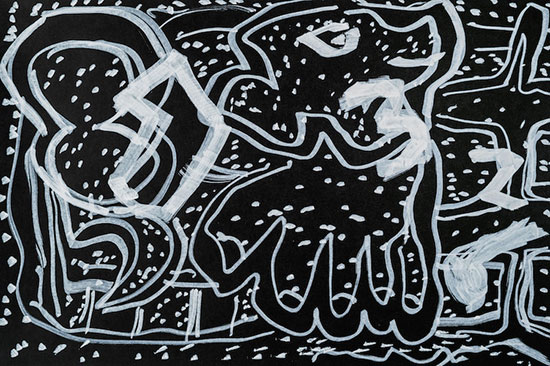
"AS 18" by Jay Milder, 2002 - 2015. Oil stick on rag paper, 12 x 18 inches.
.
Milder became a central figure in Greenwich Village in the 1960s. He showed at the Sun Gallery with Red Grooms, Bob Thompson, Lester Johnson, Emilio Cruz, and Alex Katz. He and Grooms started the City Gallery in Chelsea, which eventually became the Delancey Street Museum, a venue for many of the famous “happenings” of the era. Milder also led the Rhino Horn movement, which promoted figurative expressionism at a time when Pop and Minimalism were on the ascendant.
His work is in the collections of the New Museum, Dayton Art Institute, Chrysler Museum in Norfolk, Virginia, and Tel Aviv Museum of Art. He has had two major exhibitions in Brazil in the last decade, including at the National Museum, Brasilia in 2007 and the year before at the Museum of Modern Art in Rio de Janeiro.
His ark tied up for a brief visit in Quogue, the voyage of this emissary from the heyday of expressionism has taken him from Paris through Morocco and Provincetown and many points in between. Jay Milder brings to the Quogue Gallery an expansive diplomatic message of hope to an art scene often in need of it.
______________________________
BASIC FACTS: “Jay Milder--Noah’s Ark: Many Views” is on view May 12 to June 15, 2016 at the Quogue Gallery, 44 Quogue Street, Quogue, NY 11959. www.quoguegallery.com.
______________________________
Copyright 2016 Hamptons Art Hub LLC. All rights reserved.
